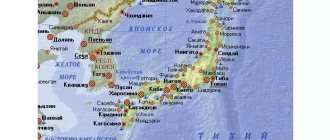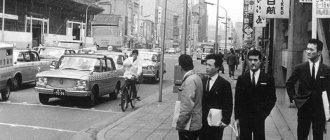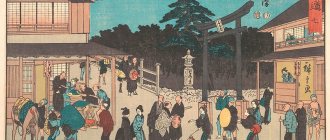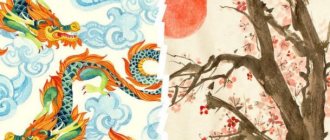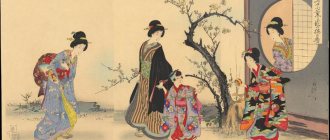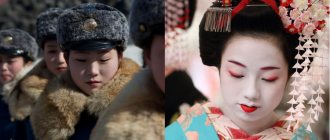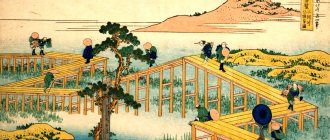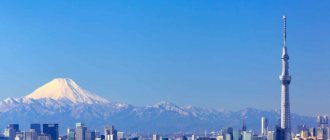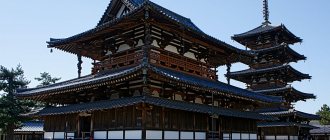Japan in the 19th century was one of the largest states, which is located in East Asia and consists of 4 thousand small islands. For two hundred years during the reign of the Tokugawa dynasty, the Land of the Rising Sun was completely isolated from foreign interference. This certainly had an impact on the formation of culture and the further development of Japan in the 19th century.
At the beginning of the 19th century, the country began to feel the active influence of the West. In the first half of Japan of the 17th century. The government decided to stop all contacts with the West, as they feared an invasion by Christian missionaries who could bring a large army with them. As a result, residents of Japan could not leave the country, and foreigners could not enjoy the amazing culture and nature of the Land of the Rising Sun.
The beginning of a new era
Japan at the beginning of the 19th century was practically protected from all contacts that could harm its existence. However, in 1853, the thirteenth President of the United States sent four warships under the strict leadership of Matthew Perry to the shores of Japan in order to establish communications between the two superpowers. This is truly a historical event. The Japanese were so amazed by the greatness of the technology presented and the power of the ships that it was from that moment that trade with the West resumed again. Moreover, a year later, an agreement was signed that regulated relations between Japan and the West. The same document provoked the construction of two ports, which contributed to the establishment of trade relations.
- Soon, similar documents appeared in Russia, Britain and Holland. Opponents actively criticized the Tokugawa policy for signing such treaties, as well as for all other unresolved problems within the state. Everything led to the Meiji revolution and the establishment of new orders.
Articles
About Japanese maps and Japan's self-isolation
This 1594 map by Gerardus Mercator shows the Japanese archipelago on the eve of the country's closure to foreigners. The foreign policy of Japan's self-isolation from the outside world was called sakoku (literally - a country on lock), it was carried out by the Tokugawa for two centuries from 1641 to 1853.
Under penalty of death, since 1636, the Japanese were prohibited from leaving the territory of their country without special government sanction, as well as from building large ships suitable for long voyages. Foreign merchants gave a special obligation to engage only in trade.
Dutchman in Japan
After the suppression of the Shimabara uprising of Catholic peasants, the shogunate, through a series of decrees, finally closed the country to foreigners, trying to suppress any foreign influence. For more information on this, see the posts About the Dutch in Japan and Christianity in Japan. In 1638, by decree of the Tokugawa, all Portuguese were expelled from the country; repression was extended to the Spaniards even earlier. All contacts with the Western world were monopolized by the Dutch, whose special position in the country was ensured by their help in suppressing the Catholic uprising. Twice a year, Korean and Chinese ships were allowed to enter only one port in the country - Nagasaki.
World map. Around 1850
This Japanese world map was created around 1850. From this map one can judge the Japanese view of their place in the world on the threshold of their forced reintegration into the international community. The Japanese archipelago is located in the center of the map, while Europe, instead of the usual central place, is placed on the western outskirts. The American continent is located on the far eastern side of the map. The continents are painted in different colors and are in the correct position in relation to each other, but their contours correspond very poorly to reality. The Red Sea is colored red, India is shown much smaller than the huge landmass of Indochina. South America was shown much more realistically than North America - the Gulf of St. Lawrence penetrates deep into the continent. The continents don't look much like their actual shapes. By 1850, the British were already busy colonizing Australia, but instead there was a mythical land on the map. However imperfect the continents may be, this map shows that Japan was not completely cut off from outside knowledge and that the Japanese had a geographical understanding of the world. Throughout the Sakoku period, significant trade and other contacts were strictly limited, but were nevertheless maintained with privileged partners.
Dejima Island
The Dutch, who were allowed to maintain a position on the small island of Dejima in Nagasaki harbor, were Japan's main source of Western scientific knowledge, including cartography. I have a post about this, a Historical page. Dejima Island. This enabled Japan to keep pace with the general development of geography, even if sometimes, as in this case, only in the most general sense. Information about Western science and culture penetrated into Japan through the Dutch trading post. Isolationist policies allowed the shoguns to oversee trade with Korea and China, minimize missionary activity by Catholic priests, and prevent European colonization of the islands.
Visits of foreign ships to Japan
A kind of gap in the structure of the sakoku were the visits to Japan of Russian traders and sailors - Pavel Lebedev-Lastochkin (1778), Nikolai Rezanov (1807) and Vasily Golovnin (1811); the last of them was detained on the island of Kunashir and spent two years in Japanese captivity. The government was also dissatisfied with the increasing frequency of British (frigate Phaeton) and French (La Perouse) ships entering Japanese harbors. In the northern part of the Pacific Ocean, American whaling successfully developed from the mid-18th century, while at the same time there was a transition from a sailing fleet to a steam one. Therefore, American whaling ships also visited Japan to purchase coal, water and food. All this led to a tightening of the sakoku policy.
Commodore Matthew Calbraith Perry (1794-1858)
After a long period of self-isolation during the Tokugawa era, Japan was discovered in 1854 by the American squadron of Commodore Matthew Perry. For more details, see the post Historical page. Second discovery of Japan. Below I place Japanese maps from my post Japanese ancient maps
"Map of the World", 1744, Geographical Institute of Kyoto University
Panoramic map of "Buddhist India", 1860
"Map of three countries (Japan, China and India)", early 19th century
"Buddhist Map of the World", 1744
"Buddhist Map of the World", mid-19th century
"Map of the World", late 16th century
"Map of the World", 1652
Reforms in Japan in the 19th century
The inhabitants of the Land of the Rising Sun, of course, were tired of the constant isolation that was imposed by the Tokugawa clan. In 1868, this dynasty was overthrown, and power returned to the hands of Emperor Mutsuhito. This was the beginning of reforms in Japan. Despite the fact that the Japanese unquestioningly honor their traditions and culture, they were also interested in Western innovations and actively put them into practice, improving and using them at their own discretion.
Japan at the end of the 19th century was a highly educated and culturally developed country. The influence of the West on the culture of the Land of the Rising Sun was great - the result was an incredibly harmonious symbiosis of the European way of life and Japanese culture.
Residents of Japan began to wear European-style clothes and listen to appropriate music. In turn, the culture of Japan in the 19th century had a direct influence on the formation of the European mentality. Other countries actively adopted all the achievements and inventions - as a result, the symbiosis of such different worlds was useful to each country.
Around the same time, Japan actively began to expand its state borders. So, in 1894 there was an attempt to seize Korea, which ultimately led to a war with China. For approximately the same reason, the Land of the Rising Sun started hostilities with Russia and annexed Korea. These events led to Japan becoming one of the most powerful powers in the entire world by 1913. This is the first Asian state to achieve such success.
Of course, the events of the 19th century left a significant imprint on the further formation of Japanese statehood. Moreover, this era contributed to the formation of Japanese culture, as well as the role of the state on the political map of the world.
Japan: the territory of the country in the 18th–19th centuries
In the 18th century, the territory of Japan consisted of three large islands (Honshu, Kyushu and Shikoku) and small islands adjacent to them. The island of Hokkaido, or Ezo as it was then called, was colonized by the Japanese only in its southernmost part. The rest of this island was inhabited by the Japanese-ruled Ainu (Ezo) tribe, which in previous centuries the Japanese had pushed to the North and partially exterminated.
The population of Japan by this time was approximately 28-29 million people. The government of the country was in the hands of the feudal Tokugawa house. Although the emperor was still formally considered the supreme owner of the land, since he had no real power, the land was controlled by the Tokugawa shogunate. In his direct possession and in the possession of his direct vassals, from whom the government apparatus and city administration were staffed, there was about a quarter of the entire territory of the country. The rest of the land was owned by the daimyo; they were divided into fudai daimyo, from among whom the highest officials of the central government apparatus were appointed, and tozama daimyo, who had long been in opposition to the Tokugawa house and were not involved in governing the country.
The territory of Japan, with the exception of the shogun's own possessions and his vassals, was divided into principalities (khan), which in literature are usually called clans; there were about 260 of them in the 18th–19th centuries. The principality was an administrative and economic unit headed by the daimyo, who was the actual owner of all the land. The highest administrative and judicial power was in the hands of the daimyo; feudal duties were collected from the peasants in his favor; his retinue consisted of samurai. Among the samurai, property was significantly undermined and, in addition to the feudal lord (daimyo), another exploiter appeared - jinushi - from rich peasants or merchants-usurers.
The exploitation of the peasantry intensified. According to the law, the usual rate of in-kind rent-tax was 50% of the harvest, but peasants and especially tenants, who paid rent to both the feudal lord and jinushi, gave a total of 70% or more of their harvest.
The growth of commodity-money relations, as well as new forms of land ownership and exploitation led to some changes in agriculture. The area under commercial industrial crops expanded - mulberry (sericulture), cotton, tea, tobacco, indigo, etc. For example, the production of raw silk increased at the beginning of the 19th century. twice as much as in the 18th century; the area under cotton and other industrial crops in some areas near large cities (Osaka, Kyoto) exceeded in the first half of the 19th century. cultivated area under rice. An indicator of the growth of money circulation was, in particular, a reduction in natural and increase in cash income of the shogunate: from 1722 to 1836, the supply of rice to the shogunate decreased by about 10%, while cash income tripled.
In the village already in the first half of the 19th century. hired labor was used. Landless and land-poor peasants worked in the spring and summer for wealthier peasants. There was a system of hiring for a year, for a month and daily.
At the beginning of the 19th century. Signs of a crisis in the subsistence economy were becoming increasingly clear. The positive results of strengthening the central government (in particular, the cessation of internecine wars), which ensured some growth in agriculture in the 17th - early 18th centuries, began to decline due to increased feudal exploitation, which put pressure on the peasants and ruined them. The size of the cultivated land area throughout the 18th and first half of the 19th centuries. remained almost unchanged (about 2.8-3 million hectares), as well as the harvest of rice (28-30 million koku *), the main crop of agriculture. Crop failures, famines, and epidemics followed one after another. Over 150 years (1690-1840), according to far from complete data, Japan experienced crop failure 22 times; famine engulfed a large part of the country.
There was also a sharp decrease in population growth and even some reduction in its numbers in certain periods.
By the beginning of the 18th century, according to rough estimates, at least 4 million people, or about 15% of the country’s total population, lived in cities (including samurai). In addition to the three main cities (Kyoto, Osaka, Edo), each with over 300-400 thousand inhabitants, some port cities and shopping centers had 60 thousand inhabitants or more. In addition, there were up to 200 castle towns in Japan.
Notes
* Koku is a volumetric measure equal to 180 liters, or 150 kg
Quoted from: World History. Volume VI. M., 1959, p. 445-447.
